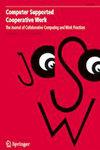基于物联网的大空间场馆建设智能能源平台
IF 2
3区 计算机科学
Q3 COMPUTER SCIENCE, INTERDISCIPLINARY APPLICATIONS
Computer Supported Cooperative Work-The Journal of Collaborative Computing
Pub Date : 2023-05-24
DOI:10.1109/CSCWD57460.2023.10152852
引用次数: 0
摘要
提出了一种基于物联网的大空间体育场馆智能能源平台。该平台可实现能源系统在各种场景下的安全稳定运行,促进低碳、高效、可持续发展。本文以物联网设备数据采集、时间序列数据存储、前端智能能源平台、后端优化模块为基础构建智能能源平台。详细介绍了平台的体系结构和框架。本研究以杭州某大空间建筑为例,说明智能能源平台在真实现场的工作原理。给出了空调系统碳排放模块和负荷预测模块的实时监测图。所开发的基于物联网的智能能源平台,可支持未来各类低碳建筑的数字化孪生运营管理。本文章由计算机程序翻译,如有差异,请以英文原文为准。
Smart Energy Platform for Large-space Stadium Construction Based on Internet of Things
A smart energy platform for the large-space stadium based on Internet of Things (IoT) is proposed. The platform could realize the safe and stable operation of the energy system in various scenarios and promote low-carbon, efficient and sustainable development. In this paper, the smart energy platform is constructed based on IoT device data collection, time series data storage, front-end smart energy platform, and back-end optimization modules. The architecture and framework of the platform are explained in details. This study takes a large-space building in Hangzhou as an example to explain how the smart energy platform works in the real site. The real-time monitoring map of carbon emissions module and load prediction module of air-conditioning system are presented. The developed smart energy platform based on IoT could support the digital twin-based operation management of various types of low-carbon buildings in the future.
求助全文
通过发布文献求助,成功后即可免费获取论文全文。
去求助
来源期刊

Computer Supported Cooperative Work-The Journal of Collaborative Computing
COMPUTER SCIENCE, INTERDISCIPLINARY APPLICATIONS-
CiteScore
6.40
自引率
4.20%
发文量
31
审稿时长
>12 weeks
期刊介绍:
Computer Supported Cooperative Work (CSCW): The Journal of Collaborative Computing and Work Practices is devoted to innovative research in computer-supported cooperative work (CSCW). It provides an interdisciplinary and international forum for the debate and exchange of ideas concerning theoretical, practical, technical, and social issues in CSCW.
The CSCW Journal arose in response to the growing interest in the design, implementation and use of technical systems (including computing, information, and communications technologies) which support people working cooperatively, and its scope remains to encompass the multifarious aspects of research within CSCW and related areas.
The CSCW Journal focuses on research oriented towards the development of collaborative computing technologies on the basis of studies of actual cooperative work practices (where ‘work’ is used in the wider sense). That is, it welcomes in particular submissions that (a) report on findings from ethnographic or similar kinds of in-depth fieldwork of work practices with a view to their technological implications, (b) report on empirical evaluations of the use of extant or novel technical solutions under real-world conditions, and/or (c) develop technical or conceptual frameworks for practice-oriented computing research based on previous fieldwork and evaluations.
 求助内容:
求助内容: 应助结果提醒方式:
应助结果提醒方式:


